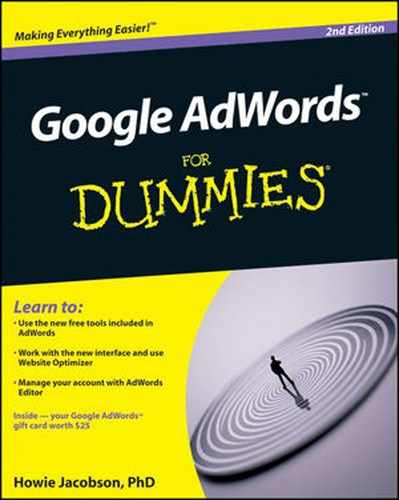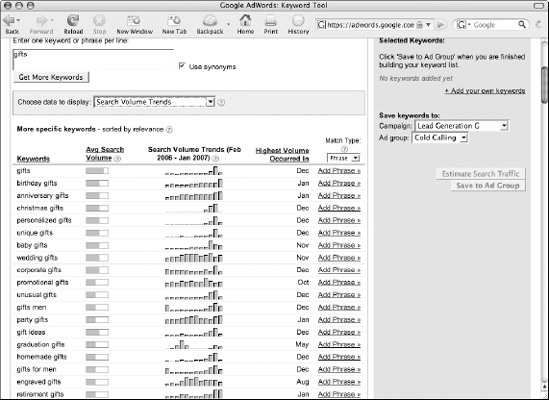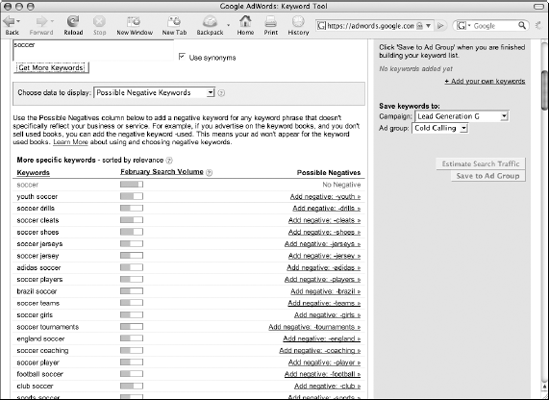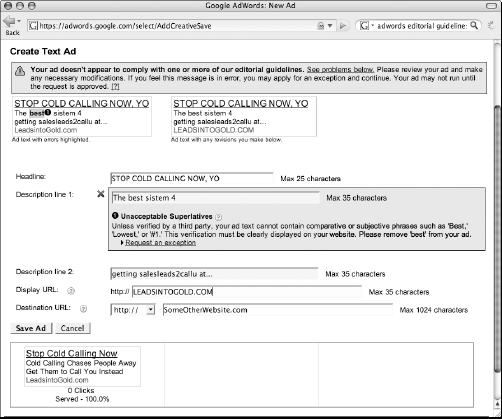In This Chapter
Improving campaigns with the Account Optimizer tools
Saving time with Google Campaign Management tools
Checking your account's vital statistics with Diagnostic tools
When my father was 12 years old in 1930, his Uncle Freddie offered to take him to a Newark Bears minor league baseball game. With the Depression raging, he couldn't afford the ticket on his own, so he accepted the offer from his notoriously stingy (and occasionally just notorious) uncle. Upon arriving at the ballpark, Uncle Freddie hustled them away from the turnstiles, around the stadium to the fence abutting the farthest outfield bleachers. Once there, Freddie knelt down and instructed my father to climb on his back and grab the top of the fence.
With a last-gasp boost by Freddie, my father vaulted the fence and toppled into the ballpark, right on top of a pair of cops hired to keep order at the raucous venue. One of the policemen roughly lifted my father up by the collar and inquired of the quivering youth, "Don't you know these games are free for kids?"
A whole industry of third-party tools has grown up around Google AdWords. Some of them, in my opinion, are indispensable (see my recommendations in Bonus Chapter 1, available as a PDF file at www.askhowie.com/bonuschapters). Others are convenient and may be worth it because of the time they save. But many are simply duplicates of free tools included (but buried) within your AdWords account. You may never need most of them. But in memory of my father's early brush with the law, I hereby introduce you to a bunch of tools that come free with AdWords. Don't let Uncle Freddie sucker you into missing out or paying extra.
The purpose of this chapter is to give you an overview of each of the free tools included with your AdWords accounts and its function, so you know to use it when you need it. This chapter is not intended to be an in-depth explanation of each tool's complete functionality. Visit www.askhowie.com/gtools for video tutorials that show you how to use them, one step at a time.
Google offers free tools for your ad campaign on the Tools page. To go to the Tools page, log on to your AdWords account, go to the Campaign Management page, and then click the Tools link under the Campaign Management tab.
Google provides four tools under the heading Optimize Your Ads that, oddly enough, focus entirely on keywords rather than ads. I don't know if Google intended this title as a bit of cryptic wisdom, but wise it is: The quality of the ad is completely dependent on the match between it and the keyword that triggers it.
You meet the Keyword tool in Chapters 4 and 5, and in this chapter I focus on some different uses. After you enter a keyword and click the Get Keyword Ideas button, select Show All from the Choose Columns to Display drop-down menu. You'll see several additional columns, including Advertiser Competition and Search Volume Trends. See Figure 9-1.
The Advertiser Competition column shows, again in relative terms, how many competitors are bidding on that keyword. If the entire rectangle is shaded, the keyword is highly competitive, at least in terms of number of competitors. Don't let large numbers of competitors scare you away from a keyword or a market without researching further: The competitors may be easy to beat through split testing (see Chapter 13) and intelligent campaign architecture (see Chapters 7 and 8).

Figure 9-1. Many "mortgage" keywords show high competition (the bar is fully colored in), and a number of keywords show a striking increase in volume in October 2008.
The rightmost column allows you to add any or all of the keywords to the ad group of your choosing. Notice that the column header prompts you for Match Type: Broad, Phrase, or Exact. The Broad match keyword is the default. Try changing it to Exact and see how the search volume and competition data change.
Tip
Don't confuse the broad, phrase, and exact terms at this stage of your keyword research — they are likely to perform very differently. (See Chapter 5 for a detailed explanation of the differences between these three match types.) If you do use this tool for adding keywords to your ad groups, do it carefully. I recommend scrolling to the bottom of the page and downloading the keywords to a text file or spreadsheet first, before dumping them into an ad group. You'll have much more control and will create better organized and better performing campaigns.
You can also choose to display cost and ad position estimates for the keyword list, based on a Max CPC of your choosing. Select Cost and Ad Position Estimates from the Choose Data to Display drop-down list, and then enter a value for the maximum CPC in the US Dollars (USD $) text box. If a visitor to your Web site is worth $4.00, for example, you can use this tool to find keywords that will break even at worst. Enter 4 and click the Recalculate button. (See Figure 9-2.)
You can sort by Estimated Ad Position to find the profitable keywords that will position your ad advantageously. If you're building a comprehensive list, remember to repeat the process for all three keyword match types: broad, phrase, and exact.
Tip
To find out Google's estimate of the CPC for each keyword for position #1, enter 100 (for $100) in the US Dollars (USD $) text box.
Tip
Google's bid price estimates are notoriously unreliable. Don't bet the farm or give up in despair based on this data. The best way to find out the actual cost of a click is to take that keyword live in your account. Even one or two clicks will give you more realistic data than all the predictive tools in the world.
The third option in the Choose Data to Display drop-down list is Search Volume Trends. This option gives you the average search volume along with two potentially interesting modifiers: the trend over the past 12 months for which data has been collected (the lag is usually a couple of months), and the month in which the search volume was highest.
The mortgage market is steady, with most keywords' trend lines staying pretty flat. A keyword like gifts shows huge seasonal fluctuation. The keywords birthday gifts and wedding gifts are steady, but Christmas gifts, personalized gifts, and unique gifts skyrocket in December and January and languish for the rest of the year, as shown in Figure 9-3.
The Possible Negative Keywords option from the Choose Data to Display drop-down list shows you related searches and gives you an easy way to hide your ads from searches containing irrelevant words. For example, if you sell soccer equipment and clothing in the United States, you would find many negative keywords upon entering Soccer in the text box, as shown in Figure 9-4. If you sell Diadora shoes but not Adidas, consider adding –Adidas to your keyword list.
This tool can save you time and hassle if each campaign represents a broad market. If one campaign includes ad groups for homeschooling math curricula, scuba gear, magic tricks, and seminars on how to take advantage of frequent-flier-miles programs, you have no need for campaign-wide negative keywords. If, on the other hand, your Whiteboards campaign consisted of ad groups for Magnetic Whiteboards, Porcelain Whiteboards, Commercial Whiteboards, Whiteboard Cleaners, Whiteboard Pens, and so on, you can use this tool to consolidate all the negative keywords in one master list. If you create a new ad group, you don't need enter the negative keywords into that group's keyword list. Some negative keywords might include these:
netmeeting Microsoft java msn
These keywords refer to online virtual whiteboards, not the ones that hang on your office walls and are ruined by the schlemiel who uses a permanent marker by accident.
You can generate campaign-wide negative keywords in one of two ways. You can enter the negative keywords manually, or "sweep" them out of individual ad groups into the campaign.
Manual exclusion: First, select a campaign from the Campaign drop-down list near the top of the page. If your campaign is new, place the negative keywords into the text box and click the Add Keywords button. You'll see them appear in the table at the bottom of the page.
Clean Sweep: If your ad groups already contain negative keywords, you can consolidate them using Clean Sweep. You can choose to sweep negative keywords found in every single group (choose All Ad Groups from the Campaign drop-down list), at least 75 percent of them, at least 50 percent of them, or keywords found in any ad group. After Clean Sweep runs, you can decide which negative keywords to apply to the entire campaign and which negative keywords to leave in their original groups only.
The Site Exclusion tool allows you to choose particular Web sites (and parts thereof) where you don't want your ads to show. This tool is relevant only for campaigns that show in the Content network.
If you want to keep your ads off an entire Web site, enter the top-level domain with and without the www prefix: www.fitfam.com and fitfam.com. To keep your ads from showing in a specific cheesy subdomain or directory within a Web site, include that information: cheesysection.fitfam.com or www.fitfam.com/cheesysection and fitfam.com/cheesysection. You can also specify a particular page, such as www.fitfam.com/embarrassingpage.html for exclusion.
You must set site exclusion separately for each campaign.
Suppose you don't want competitors to see your ads. Maybe you don't want them to know what you're up to. Or perhaps you suspect them of "click fraud" — clicking away on your ads just to cost you money. You can use the IP Exclusion tool to hide your ads for IP addresses that you specify. If you know the IP address of the server used to surf the Internet, you can enter it on a campaign-by-campaign basis.
The Traffic Estimator can quickly help you avoid markets and market segments that simply don't generate enough search volume to justify a campaign, as well as help you estimate your sales volume and profitability. This tool calculates search traffic only, from Google and its partners. It does not include clicks you may receive from sites on the Content network.
Begin by entering a keyword or keywords into the text box at the top of the page. Next, enter a very high Maximum CPC. I always start with Google's maximum, $100, to find out what Google thinks I'll have to pay to get position #1. Ignore the daily budget for right now. Because you're talking about $100 clicks, you can enjoy fantasyland a little longer.
Now, choose your customers' languages and locations, just as you would in setting up a new campaign (see Chapter 7). Click Continue to see how much Google thinks you'll pay for the top spot for each keyword, and how many clicks each one will generate. Google assumes your ads' CTRs will be the same as those of current advertisers bidding on these keywords. If your ads are more attractive, your average CPCs will be correspondingly lower.
In Figure 9-5, the top position for Whiteboard keywords can be had for $3–$5 per click. Assuming your ads are as appealing (or unappealing) as everyone else's, Google thinks you'll be parting with $480–$660 per day for the privilege of showing your ads in position #1 to viewers in the U.S. and Canada. Based on its data for ads showing at that position for these keywords, Google estimates 108–117 visitors per day to your Web site (let's call it 112.5 on average). If your Web site can turn exactly 3 percent of your visitors into paying customers, and your average order amount is $500 at a 50 percent profit margin, then your gross daily profit from this campaign will be, on average, $843.75 ($500 × .50 margin × 3.375 sales). Subtracting the daily advertising spend (let's call it $520), your net at the end of each day is $323.75.

Figure 9-5. Google estimates your daily clicks and cost per day for your keywords, based on how much you're willing to bid and where you intend to show your ads.
Download this table as a spreadsheet readable by Microsoft Excel by clicking the Download as .csv button at the bottom of the page. After you've saved the table, enter a saner amount in the Maximum CPC text box at the top left, and then click the Get New Estimates button. In Figure 9-6, you can see the results of capping your maximum bid at $2.00.
Now you get around 80 clicks per day for around $120. Assuming the same Web-site conversion process, you average 2.4 sales per day, for a daily profit of $600.00. Subtracting your AdWords costs leaves you with $480 net profit. Bidding lower and generating fewer clicks appears more profitable, based on this simulation.

Figure 9-6. Dropping your bid to $2.00 produces almost as many clicks at a much lower estimated daily cost.
Note
The Web-site conversion for clicks not from position #1 is likely to be higher, because your ad attracts fewer happy clickers and more serious prospects. The lower bid is likely to be even more profitable than the preceding scenario projects.
Keep playing with the Maximum CPC until you find the scenario that produces the highest net profit. You can become even more granular by adding individual Max CPCs to the keywords, using the keyword**1.50 format on the first page of the Traffic Estimator. Until you track the actual sales performance of keywords (so you know exactly the optimal bid for profitability), the Traffic Estimator is a good place to start.
This recent addition to the AdWords tool family will help you explore seasonal trends and geographic distribution of keywords. It has far too many features to describe here. If you want to know where in the world the most people search for ramen noodles or when Campus Ladies was hot, this tool provides hours of fun.
When you put an ad in your local paper or hire a kid to wear a chicken suit in July and hand out flyers for your Buffalo Wings Shack, it's pretty easy to tell whether the ad appears or the kid shows up and shakes his tail feathers. The world of online advertising is not so apparent, so Google provides some tools to help you monitor where and when your ads are showing.
To use the Ad Performance tools, log on to your AdWords account, go to the Campaign Management page, and click the Tools link under the Campaign Management tab. Click the link for the tool you want to try out under the Analyze Your Ad Performance heading.
The Conversion Tracking tool is important enough to merit its very own chapter, so I don't belabor it in this chapter. Flip to Chapter 14 to find out all about the Conversion Tracking tool.
Want to find out whether searchers are seeing your ads for your favorite keywords? Click the Ads Diagnostic Tool link on the Tools page. With the Ads Diagnostic tool, you can enter a keyword, choose parameters, and ask Google to indicate the ads that appear for a given search term. In Figure 9-7, Google will show the ads that appear in the Chicago, IL area for the phrase-match keyword IT consultant.
Tip
Note that you are not limited to the straight www.google.com search; you can also check other Google domains, such as maps.google.com or google.co.za (the South African Google home page), by entering the URL in the Google Domain text box. You can specify a geographic location, just as you do when targeting a campaign, choose the language(s) your customers speak, and even specify individual IP addresses for laser targeting. This is very useful for advertisers who can't see what their far-flung prospects in other regions or countries are viewing during searches.
Google offers a second option to diagnose a missing ad. Option 2: Search Results Page URL, at the bottom of the page, allows you to paste the entire URL of a search page into the Search Results Page URL text box. To use this option, open another Web browser window, perform a Google search, and then select and copy the entire text of the URL in the Address bar.

Figure 9-7. Asking Google which ads display when someone in the Chicago area searches for the phrase match "IT consultant".
To be sure you've selected the entire address, perform the following steps:
Right-click anywhere within the URL in the Address bar and choose Select All.
Right-click again and choose Copy.
Return to the Ad Diagnostic tool, right-click your cursor in the Option 2 text box, and then select Paste.
Click the Continue button.
For either option, when you click the Continue button, Google shows you not only the ads that will show for that keyword, but also the ads that you would like to show, but aren't. Google also provides tips and strategies for fixing the problem, as shown in Figure 9-8.
Your ad might be slacking off for a number of reasons:
Ad not showing on first page: Your ad is showing, but not on the first page. Google suggests raising your minimum bid, increasing your CTR, or targeting more specific keywords.
Ad not shown because of low quality keyword: Google gives each keyword a quality score (see Chapter 7). If your keyword quality is Poor or OK, Google penalizes you by making that keyword more expensive. Your options here include improving the keyword-to-ad-to-landing-page match (opening your mind) or bidding higher (opening your wallet).
Ad not shown because one of your other ads is showing for this keyword: Google lets your campaigns and ad groups compete against each other, but will let only one win at a time. You won't see two of your ads showing for the same keyword, even if you bid on that keyword in multiple ad groups or campaigns. Google chooses the one with the highest ranking, which generally means the one that makes Google the most money (they aren't stupid). If you want the missing ad to show, either decrease the duplicate keyword(s) or raise your bid on this keyword.
Ad not shown because of paused campaign, ad group, or keyword: If you pause a part of your account, Google stops showing it. Obvious, yes, but when accounts get large, it's easy to forget that you never turned that ad group back on after pausing it for maintenance.
Ad not shown because negative keyword or Non-Family Safe classification is preventing your ad from showing: If you dump a lot of negative keywords into your campaigns or ad groups, you may inadvertently cause a conflict between a positive and negative keyword. The Non-Family Safe classification means that your ad is deemed inappropriate for minors, and will be shown only to searchers who turn off the adult filters (few do). Unless you're selling adult entertainment (I love that euphemism!), make sure your ads would be at home on Captain Kangaroo.
Ad not shown because disapproved ads or keywords: If your ad is disapproved due to a violation of Google's editorial guidelines (see
https://adwords.google.com/select/guidelines.htmlfor the actual document you "signed" when you gave Google your first five dollars), use the tool in the next section to discover possible remedies.
I know you want to deduct that 45-country trip as a business expense, but it's not necessary to travel to see the Google search results from around the world. Simply enter a keyword, domain, and language; and then choose a country and region to view (but not interact with) the Google results page that searchers in that area would see.
I'm such a good boy that I can't show you screen shots for disapproved ads. The best I can do is let you see what happens when I try to write one, as shown in Figure 9-9.
Some ads can be fixed by requesting exceptions. If you sell MAS90 accounting software, originally created by Best Software, you may be able to use the Best brand name. If you use a medical term in an ad, you may trigger the "Uh-oh, it's a Canadian Pharmacy" policy. Click the Request an Exception link and explain to a live Google editor why this rule doesn't apply to your ad or keyword in 300 characters or fewer (now's not a good time to go into your childhood).
The My Change History tool was created for those suffering from CRetTNS (Can't Remember to Take Notes Syndrome). You can find specific changes by filtering out the irrelevant ones. Google allows you to filter changes by date, campaign and ad group, users (in case you set up more than one user for your account), and type of change.
Tip
I find this tool useful when I want to examine my campaign or run a report to see the effects of a particular change. You can specify start and end dates in the Campaign Summary control panel and in reports. The My Change History tool helps you remember which dates to select to get a clean experiment.
For example, let's say you lowered a bunch of bids around the beginning of March, but you can't remember exactly when, and you want to see the effect this change has had on your business.
Figure 9-10 shows three Max CPC changes, two on February 13 and one on March 2 at 1:30 p.m. You can now look at the two weeks prior to March 2 and the two weeks following March 2 (for example) to compare your statistics for these two phases of the experiment. You can look at impressions, clicks, average position, total cost, conversions, sales, and such. If the only difference in the two periods is the change you identified, you have learned something by isolating that variable in time using the My Change History tool.
Note
Even though you can fall back on this tool, please spend a buck on a notebook and pretend you're in high school chemistry class again. Taking notes on your questions and changes helps you monitor your account more seriously, and puts you in an observant and curious AdWords mindset.
This tool is so cool, it deserves — and gets — its own chapter (Chapter 14).
AdWords Editor is a free desktop program that allows you to make changes to your AdWords account while you're offline. After you download it to your computer (they have PC and Mac versions), you can copy and paste ads, keywords, ad groups, and even entire campaigns in seconds.
AdWords Editor includes powerful search features. For example, you can find, all in one list, every ad that includes a particular destination URL. If you need to change that URL, you can do it globally via the editor, instead of piecemeal in the online AdWords interface.
As AdWords consultant David Rothwell of AdWordsAnswers.com points out, you can also use the editor to back up your account, in case your account is hacked or you just make a bunch of changes you later regret.






